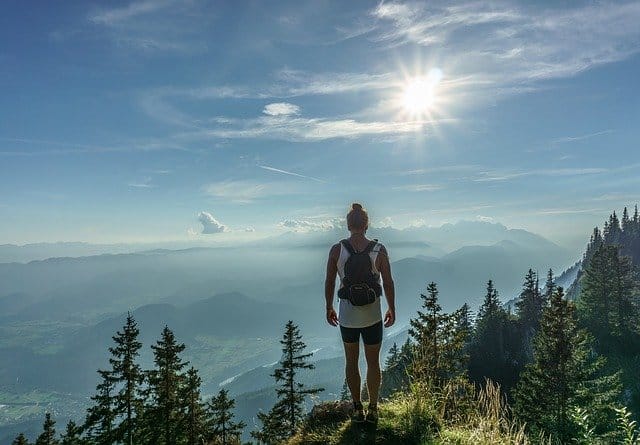While you’re more than likely familiar with hiking, you might be a little less sure of what speed hiking is and what it entails.
Speed hiking or fast hiking as it is sometimes called is a form of hiking that is done at a faster pace than a walk but slower than a run.
For example, most hikers will use a moderate walking pace when hiking usually covering approximately 2 miles in an hour.
Trail runners on the other hand will usually cover somewhere between 7 to 10 miles in that same hour.
While speed hikers will usually fall somewhere in the middle of these two extremes averaging approximately 3 to 5 miles in an hour.
To visually see what speed hiking looks like in practice, check out this beautifully shot YouTube video on speed hiking.
After, watching this video if you’re inspired to try speed hiking for yourself, there are some additional things you should be aware of as well as some best practices to follow before trying speed hiking.
Speed Hiking Explained
While there are no strict rules around speed hiking below is a general list of commonly followed guidelines and concepts that encompass the idea and spirit of speed hiking.
- The overarching goal of speed hiking is to cover as much ground and elevation change as quickly as possible.
- While the pace can vary from one-speed hiker to the next, the best way to describe the pace of a speed hiker or fast hiker is an extremely brisk walk or slow jog.
- Many speed hikers will vary the pace while hiking, changing the pace from a brisk walk to a full-out jog, depending on the terrain and difficulty of that section of the trail.
- While speed hiking can include overnight camping, most speed hikes are day hikes that rarely go into a second day.
- Most speed hikers keep it light on the trail opting for trail runners or lightweight hiking shoes as opposed to heavier hiking boots, and keep their hiking gear as light and minimal as possible.
- Many speed hikers will use the aid of trekking poles in order to help maintain their balance and footing over uneven and rough terrain as well as to increase speed.
- Often times speed hikers will start their hike before the sun comes up and end their hike long after the sun goes down using the aid of headlamps and flashlights to maximize the amount of distance they can cover in one day.
Speed Hiking Pros and Cons
While speed hiking is a great way to get outdoors and be active, speed hiking is not necessarily a good fit for everyone, so before you decide on whether speed hiking is right for you take a look at all the pros and cons first.
Pros
- While traditional hiking is a great form of exercise, speed hiking takes it to the next level providing an excellent whole-body aerobic workout to help improve your overall fitness level and conditioning.
- Speed hiking allows you to cover more miles of trail in the same amount of time compared to traditional hiking.
- Speed hiking is a great way to mix things up, for those hikers looking for a new experience or challenge while hiking.
- For hikers that don’t have a lot of free time, speed hiking is a great way to enjoy hiking.
- Speed hiking lets you see and experience more trails and views in less time.
Cons
- While speed hiking there is little time to appreciate and enjoy the nature and wildlife around you.
- Speed hiking by its very nature is a fast-paced and hectic style of hiking, eliminating one of the major benefits of traditional hiking which is to slow down our often hectic lives with a stroll through nature.
- Due to the increased pace of speed hiking or fast hiking, the chance for injury increases from uneven terrain and falls.
- Speed hiking is not an activity that can be enjoyed by all due to its higher required level of fitness and stamina which can limit the number of hikers in your usual hiking group that can participate.
Different Hiking Paces Compared
To give you a better idea of how hiking pace can affect the amount of time needed for a hike and the distance you can cover while hiking we created this helpful table.
| Type of Hike | Pace | Time Needed to Complete a 5 Mile Hike | Time Needed to Complete a 10 Mile Hike | Number of Miles Covered in an 8 Hour Hike |
| Traditional Hiking | 2 MPH | 2 Hours 30 Minutes | 5 Hours | 16 Miles |
| Speed Hiking | 3 to 5 MPH | 1 Hour 40 Minutes to 1 Hour | 3 Hours 20 Minutes to 2 Hours | 24 Miles to 40 Miles |
| Trail Running | 7 to 10 MPH | 43 Minutes to 30 Minutes | 1 Hour 25 Minutes to 1 Hour | 56 Miles to 80 Miles |
How to Hike Faster or Speed Hike
While you might think there really isn’t much to speed hiking other than just trying to hike faster than you normally would, there are actually several different hiking techniques and best practices that you can use to help increase your overall hiking speed exponentially.
Off Trail Training
Perhaps the best place to start when trying to hike faster or increase your hiking speed is the training you do while you’re not hiking, as your general fitness level and condition will be the biggest factor that dictates how quickly and for how long you can hike.
There are several different types of exercises you can do to help increase your overall fitness level and condition for hiking which will in turn increase your hiking speed and stamina while speed hiking.
Best Exercises to Increase Your Hiking Speed and Stamina
- Running or jogging on a treadmill or while outside will help to increase your overall fitness level allowing you to hike faster and for longer.
- Inclined treadmill running or walking will help isolate your specific hiking muscles in your legs allowing you to climb hills and traverse uneven ground faster and longer.
- Lunges and step-ups are a great way to increase the strength of your legs for hiking and to add a little extra resistance and difficulty consider holding dumbells or kettle balls while performing lunges or step-ups.
- Use either a stair climber or actual stairs to isolate and strengthen your leg muscles which will lead to quicker and longer hiking abilities.
- Squats are another way to improve the strength in your legs muscles to increase your overall hiking pace and time.
Reduce the Weight of Your Hiking Gear
In order to increase your overall hiking speed as well as your stamina while hiking it’s also important to take a look at your hiking gear.
Starting with your shoes when trying to increase your hiking speed it’s best to leave the heavy hiking boots at home and instead opt for a lightweight trail running shoe or hiking shoe instead. Also when it comes to your hiking clothes try to use lightweight synthetics whenever possible as opposed to heavier cotton or wool blends.
As far as additional hiking gear goes if you don’t absolutely positively need it for the particular speed hike you are going on, leave it behind. For most speed hikers the only additional hiking gear they bring is a small day pack, water, lightweight food options, trail map, compass, light source, and trekking poles.
If you’re looking for great lightweight hiking gear that was designed for speed hiking and lightweight hiking you should definitely check out Selewa’s website as they have some of the best lightweight hiking gear on the market today.
Plan Your Breaks Ahead of Time and Make them Multi-Purpose
When traditional hiking most hikers haphazardly take breaks when they feel like it with no real plan or agenda for the break, often leading to disorganized and more frequent breaks.
A better practice when trying to speed hike and increase your hiking speed though is to plan your breaks ahead of time and make sure you are accomplishing multiple activities while on the break such as rest, hydration, bathroom breaks, lunch, etc…
A great way to accomplish this is by using a trail map before you head out to look for good locations to stop at that allow for more than one purpose.
Consciously Work to Increase Your Hiking Pace
When hiking, most hikers will set their hiking pace similar to the general walking pace they use every day without thinking much about it, when in fact their fitness level would allow them to comfortable hike at a much faster pace.
So when setting your hiking pace for speed hiking don’t set that pace subconsciously and instead strive to set the pace consciously throughout the hike with a focus on speed.
One way to do this is to consciously focus on getting your lead leg out in front of you as fast as possible to help increase your overall hiking speed.
When Hiking Uphill Shorten Your Stride
Taking smaller strides while going uphill has long been known in the running community as a way to climb hills faster and with less energy and this same concept applies just as well when speed hiking.
When going uphill in order to increase your hiking speed and to conserve energy focus on making rapid and short quick strides as this will allow you to traverse the hill faster and require less energy.
A good way to think about this concept is by imagining the shorter and more rapid steps as a way of dividing up the hill into smaller and more manageable pieces.
When Hiking Downhill Lengthen Your Stride
While you want to shorten your stride while going uphill to increase speed and conserve energy you want to do the opposite while going downhill and lengthen your stride instead.
This is because the downhill motion will naturally propel you forward and by lengthening your stride you will be able to benefit more from this by covering a greater distance with each stride with little extra effort. Thereby increasing your overall hiking pace with little additional energy requirements.
Incorporate Trekking Poles into Your Hike
While trekking poles are used for a variety of reasons while hiking including stability, control, and rhythm another great use for trekking poles is speed.
Trekking poles can actually add a lot of speed to your hike just as a by-product of the extra control and stability they provide by allowing you to maintain your footing and stability at higher hiking speeds than you could without them.
In addition, trekking poles allow you to incorporate your arms into the hiking motion and stride allowing the strength of your arms to help propel your forward faster than what would be possible on just your legs alone.
How to Get Started Speed Hiking
Know that we have learned what speed hiking is, its pros and cons, and how to hike faster the only thing left to do now is head out for your first speed hike.
As with anything though when first starting out it’s best to take it easy and make sure not to overexert yourself or get in over your head.
So for your first few speed hikes choose trails you are already familiar with and keep the elevation change and length to a minimum so you have a safe and comfortable place to practice speed hiking.
Then once you become a little more experienced with speed hiking and have a better idea of your fitness level and conditioning you can gradually work up to longer distances with more elevation change as your fitness level and conditioning increase.


